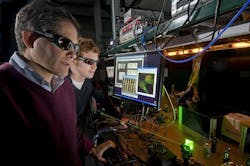East Lansing, MI--As detailed in the current issue of Applied Physics Letters, Marcos Dantus, Michigan State University (MSU) chemistry professor and founder of BioPhotonic Solutions, has developed a laser that can detect micro traces of explosive chemicals on clothing and luggage. This research, says MSU, has put the possibility of bomb-detecting lasers at security checkpoints within reach.
"Since this method uses a single beam and requires no bulky spectrometers, it is quite practical and could scan many people and their belongings quickly," Dantus said. "Not only does it detect the explosive material, but it also provides an image of the chemical's exact location, even if it’s merely a minute trace on a zipper." This doesn't mean that security forces will be armed with handheld laser in airports, however. This laser would more likely be in a conveyor belt, like the X-ray scanners already used for airport security. The low-energy laser is safe to use on luggage as well as passengers, he added.
For decades, scientists have been working to develop lasers that are powerful enough for detection, but safe enough to use on people. Dantus' initial spark for this breakthrough came from collaboration with Harvard University that developed a laser that could be used to detect cancer, but has the beam output of a simple presentation pointer.
"While working on biomedical imaging, I began exploring additional applications," Dantus said. "We soon learned how effective it was for detecting traces of hazardous substances from distances up to 10 meters away." Dantus' bomb-detecting laser works as a single beam, but uses two pulses. The first resonates with certain chemical frequencies found in explosives. The second, a shadow pulse, serves as a reference. A discrepancy between the two pulses indicates the presence of explosive materials.
"The laser is not affected by the color or surface of clothes or luggage," Dantus said. "The resonant pulse and the shadow pulse are always in balance unless something is detected. Our method has Raman chemical specificity, excellent sensitivity and robust performance on virtually all surfaces."
An aerospace company has already expressed interest in furthering this technology. With additional funding, a standalone prototype could be created in about one year, he added.
Funding for this research was provided by the Department of Homeland Security, Science and Technology Directorate. BioPhotonic Solutions is a high-tech company Dantus launched in 2003 to commercialize technology invented by his research group at MSU.
SOURCE: Michigan State University; http://msutoday.msu.edu/news/2013/bomb-detecting-lasers-could-improve-security-checkpoints/
About the Author

Gail Overton
Senior Editor (2004-2020)
Gail has more than 30 years of engineering, marketing, product management, and editorial experience in the photonics and optical communications industry. Before joining the staff at Laser Focus World in 2004, she held many product management and product marketing roles in the fiber-optics industry, most notably at Hughes (El Segundo, CA), GTE Labs (Waltham, MA), Corning (Corning, NY), Photon Kinetics (Beaverton, OR), and Newport Corporation (Irvine, CA). During her marketing career, Gail published articles in WDM Solutions and Sensors magazine and traveled internationally to conduct product and sales training. Gail received her BS degree in physics, with an emphasis in optics, from San Diego State University in San Diego, CA in May 1986.
